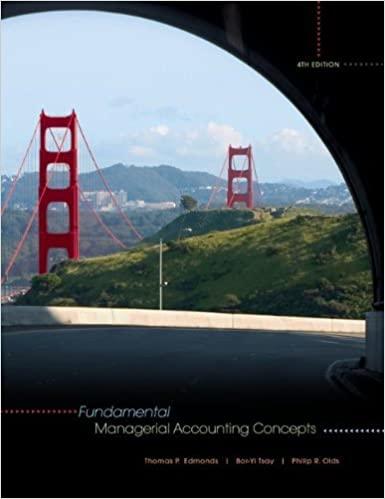Manufacturing cost flow for multiple accounting cycles The following events apply to Beach Manufacturing Company. Assume that
Question:
Manufacturing cost flow for multiple accounting cycles The following events apply to Beach Manufacturing Company. Assume that all transactions are cash transactions unless otherwise indicated.
Transactions for the 2006 Accounting Period 1. The company was started on January 1, 2006, when it acquired $1,000,000 cash by issuing common stock.
2. The company purchased $600,000 of direct raw materials with cash and used $52,000 of these materials to make its products in January.
3. Employees provided 1,500 hours of labor at $16 per hour during January. Wages are paid in cash.
4. The estimated manufacturing overhead costs for 2006 are $1,300,000. Overhead is applied on the basis of direct labor costs. The company expected $260,000 of direct labor costs during 2006.
Record applied overhead for January.
5. By the end of January, the employees completed work on all inventory items started in January.
The cost of this production was transferred to the Finished Goods Inventory account. Determine the cost per unit of product produced in January, assuming that a total of 10,000 units of product were started and completed during the month.
6. The company used an additional $468,000 of direct raw materials and 13,500 hours of direct labor at $16 per hour during the remainder of 2006. Overhead was allocated on the basis of direct labor cost.
7. The company completed work on inventory items started between February 1 and December 31, and the cost of the completed inventory was transferred to the Finished Goods Inventory account.
Determine the cost per unit for goods produced between February 1 and December 31, assuming that 90,000 units of inventory were produced. If the company desires to earn a gross profit of $6 per unit, what price per unit must it charge for the merchandise sold?
8. The company sold 60,000 units of inventory for cash at $25.60 per unit. Determine the number of units in ending inventory and the cost per unit of this inventory.
9. Actual manufacturing overhead costs paid in cash were $1,220,000.
10. The company paid $300,000 cash for selling and administrative expenses.
11. Close the Manufacturing Overhead account.
12. Close the revenue and expense accounts.
Transactions for the 2007 Accounting Period 1. The company acquired $600,000 cash from the owners.
2. The company purchased $400,000 of direct raw materials with cash and used $41,600 of these materials to make products in January.
3. Employees provided 1,200 hours of labor at $16 per hour during January.
4. On January 1, 2007, Beach expected the production facilities to cost $3,000 cash per month. The company paid cash to purchase $14,000 of manufacturing supplies, and it anticipated that
$14,000 of these supplies would be used by year end. Other manufacturing overhead costs were expected to total $910,000. Overhead is applied on the basis of direct labor costs. Beach expects direct labor costs of $160,000 during 2007. Based on this information, determine the total expected overhead cost for 2007. Calculate the predetermined overhead rate and apply the overhead cost for the January production. Also, record the purchase of manufacturing supplies.
5. The company recorded a $3,000 cash payment for production facilities in January.
6. On January, the employees completed work on all inventory items started in January. The cost of this production was transferred to the Finished Goods Inventory account. Determine the cost per unit of product produced in January assuming that a total of 8,000 units of product was started and completed during the month.
7. During February 2007, the company used $31,200 of raw materials and 900 hours of labor at $16 per hour. Overhead was allocated on the basis of direct labor cost.
8. The company recorded a $3,000 cash payment for production facilities in February.
9. In February, the employees completed work on all inventory items started in February; the cost of this production was transferred to the Finished Goods Inventory account. Determine the cost per unit of product produced in February, assuming that 6,000 units of product were started and completed during the month.
10. The company used an additional $286,000 of direct raw materials and 8,250 hours of direct labor at $16 per hour during the remainder of 2007. Overhead was allocated on the basis of direct labor cost.
11. The company recorded $30,000 of cash payments for production facilities for the period between March 1 and December 31.
12. The company completed work on inventory items started between March 1 and December 31.
The cost of the completed goods was transferred to the Finished Goods Inventory account.
Compute the cost per unit of this inventory, assuming that 55,000 units of inventory were produced.
13. The company sold 90,000 units of product for $28 per unit cash. Assume that the company uses the FIFO inventory cost flow method to determine the cost of goods sold.
14. The company paid $260,000 cash for selling and administrative expenses.
15. As of December 31, 2007, $2,400 of production supplies was on hand.
16. Actual cost of other manufacturing overhead was $922,000 cash.
17. Close the Manufacturing Overhead account.
18. Close the revenue and expense accounts.
Required
a. Open T-accounts and record the effects of the preceding events.
b. Prepare a schedule of cost of goods manufactured and sold, an income statement, a balance sheet, and a statement of cash flows for each year.
Step by Step Answer:

Fundamental Managerial Accounting Concepts
ISBN: 9780073526799
4th Edition
Authors: Thomas Edmonds, Bor-Yi Tsay, Philip Olds






